Cuba
December, 2000
Our Trip
Thursday, November
30 Travel day
Friday December
1, Capitol, Theater / Ballet
Saturday December
2 Cemetery, Hemingway House, Port, Fort
Sunday December
3, Car Tour, Lennon / Lenin, Tropicana
Monday December
4 Museum
Tuesday December
5 Travel home
The lead up to the trip:
My uncle, Harold, at 70 years old,
wanted to go to Cuba. He was not in the best of health, and he could only walk a very
short distance before he had to sit and rest. But he wanted to see Cuba, and
I wanted to see Cuba. It is a Communist country. I was intrigued
with Communism at a very early age. I wrote (and Dad typed) my Civics term paper
"Our right to Democracy Impedes on Their Right to Communism". I was 12 years
old.
Then I heard Harold wanted to go to Cuba. I said Yes
immediately. I wasn't till later that I realized why:
I
had been to several Communist countries in the world, so I really wanted to see
Cuba. Here's my current vitae:
Current communist (Marxist-Leninist) states that I
have visited: China, Cuba, Vietnam
Non-communist states with communist majority that I
have visited: Nepal
Previous communist states that I visited: Czechoslovakia, East Germany, Poland,
Soviet Union, Yugoslavia
Post-Soviet states that I have visited: Belarus,
Estonia, Latvia, Lithuania, Russia
The one current communist (Marxist-Leninist) state
that I have NOT visited is Laos.
BTW, North Korea is NOT communist!!! It is
"Juche", which is a Socialist state although the government's official ideology
is now the Juche part of Kimilsungism, Kimjongilism policy of Kim Il-sung, as
opposed to traditional Marxism, Leninism. In 2009, the constitution of the DPRK
was quietly amended so that not only did it disavow all Marxist "Leninist
references present in the first draft, but it also dropped all reference to
'Communism'.
I jumped on the opportunity to tell the family I would
take him. The family was not happy. I was ecstatic about the opportunity and I arranged
it.
I found a web site: Cubatravelusa.com
that could handle all the bookings.
We had to get to Cancun and "Dan" would take care of the rest. The trip was six
days/five nights: Thursday, November
30 to Tuesday, December 4.
There is a list of hotels on their
web site http://www.cubatravelusa.com/hotel_only_prices.htm
I picked the Plaza hotel because
of the location. In 2000 the rates
were
Plaza Hotel
Nov 1- Dec 14
46 per person for a double
71 for a single
Now, in 2017 the Plaza is a four-star hotel and rates are
Plaza Hotel
Nov 1- Dec 21
139 per person for a double
227 for a single
Our confirmation and invoice:
I have confirmed the following reservations:
-
November 30.....fly to Havana on Aerocaribe at 7:25
P.M.
-
November 30 - December 4 (5 nights).....Plaza Hotel
(two beds)
-
December 5.....return to Havana on Aerocaribe at
7:00 A.M.
-
INVOICE: Total package price is $544 per person.
-
-
Seriously!
$544 per person. I mailed
a check to "Dan" in Texas.
Thursday, November 30
Travel day
I flew from Atlanta to Houston to
Cancun. Harold flew from Tulsa to Houston to Cancun. I got there an hour before
Harold. At the Aerocaribe counter, I found the Divermex rep and gave him my confirmation
number. He gave me our airline
tickets, vouchers for the Hotel Plaza, including breakfast, voucher for the transfer,
and for the visa.
He said we would have to pay $15 cash for the visa per person,
and a $20 departure tax per person in both Cancun and Havana when you leave.
He said to use the birth certificate and picture ID when you
enter Mexico, and re-enter the U.S. Use your passport only to enter and exit Cuba,
but ask them NOT to stamp your passport. For
more details, go to
http://www.cubatravelusa.com/Travel_Tips.htm
Harold did a little research and packed medical supplies, including
band aids, aspirin,
gloves, vitamins, soap
The goal was to try not to spend money in Cuba.
The exchange rate was 20 pesos is $1 USD.
We
flew to Havana on Aerocaribe at 7:25 P.M.
c.jpg)
The Arrival Hall in Havana was HOT and it was crowded.
There was
a very long and winding line in the Havana arrival hall.
Small room, maybe 200 people zig zagging around each other.
Very hot. Very, very hot. No place to sit.
Harold was a trouper. We were
probably standing for over 2 hours‚¦
Get to the window, they look at the US passport then hand it back to me.
We finally arrived at the Plaza Hotel at 1 am. There were
no rooms available! Oh noo! We were oh
so very, very tired. They found a room at another hotel and arranged a taxi.
.jpg) This
is Harold in the shuttle to the other hotel, the Habana Riviera
www.hotelhavanariviera.com
Address: Paseo No-1 e/ 1ra and Malecon,
Vedado, Havana, Havana 10400
This
is Harold in the shuttle to the other hotel, the Habana Riviera
www.hotelhavanariviera.com
Address: Paseo No-1 e/ 1ra and Malecon,
Vedado, Havana, Havana 10400
From their web site: A veritable 50s
museum with a convenient location on Havana's emblematic seafront promenade (Malecon).
Finally, we are in a room with beds, and get to sleep.
Then morning. What a view! Amazing
ocean waves pelting the road, spraying the cars.
This is my picture from our hotel room:
d.gif)
From our hotel room: What? a coffin-shaped
swimming pool?
In Parque Central there are 8 coffin-shaped
stonemasons representing medical students shot by the Spanish Government of the
Island during the Ten Years' War on November 27, 1871. I wonder if that is why
this swimming pool at our hotel is coffin-shaped?
.jpg)
El Malecon is the avenue that runs beside the seawall
built along the northern shore of Havana. It stretches for 5 miles along
the coast in Havana, Cuba.
It forms the northern boundary of Old Havana, Centro Habana
and Vedado.
This picture is from:
http://www.boston.com/bigpicture/2009/11/scenes_from_havana.html
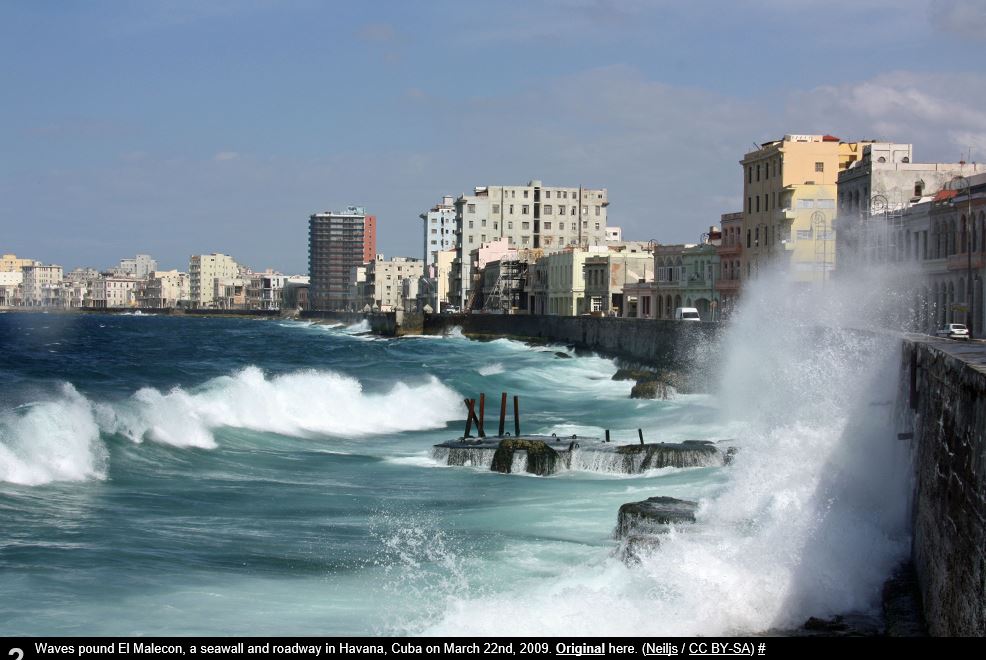
Friday December 1, Capitol, Theater / Show
We checked out of the Riviera hotel, checked into Plaza Hotel.
http://www.hotelplazacuba.com/
Ignacio Agramonte No. 267, Habana Vieja, La Habana, Old Havana, Havana, Cuba Old
Havana
This is my picture of the Plaza Hotel. Old fuel truck,
and horse carriages out front.
b.gif)
.jpg) Here
is
Harold enjoying the bed, with the television remote in hand. I can't remember if we had any English television
channels.
Here
is
Harold enjoying the bed, with the television remote in hand. I can't remember if we had any English television
channels.
It was nice room with two beds, in a great location. From their
web site:
This is from the Plaza hotel web site: Surrounded by the Museum of Fine Arts, the Bar Floridita,
the Capitolio, Central Park and more of Havana's top sights, Hotel Plaza offers
good accommodation at a good price and the location can't be beat.
The Plaza Hotel lobby
. .jpg)
The Plaza Hotel Atrium
.jpg)
This is my picture of our view from the Plaza Hotel.
Seriously. It doesn't get any better than this:
Parque%20Central2.jpg)
Arturo took us on walking
tour.
Parque Central
was across the street from the hotel and we
walked to the Capitol and the Grand Theater.
b.jpg)
"El Capitoloi Nacional"
(National Capitol Building)
b.gif)
National Capitol Building (El Capitolio Nacional)
Built 1926 - 1929.
8,000 laborers worked 8-hour shifts 24 hours a day, and completed
the building in 3 years and 50 days.
Dome is a 300 feet (92 m) high. It looks like United States
Capitol in Washington, D.C. but "richer in detail".
The architect claimed to take his inspiration for the cupola from the Pantheon
in Paris.
It was the seat of the government in Cuba - The Cuban Congress,
both the House of Representatives and Senate were based in the building until the
Cuban Revolution in 1959. Congress
was abolished and disbanded .
The building is now home to the Cuban Academy of Sciences (Museo
de la Cuidad) and the National Museum of Natural History (Museo Nacional de Historia
Natural)
There are 12 granite Roman style 46- foot tall columns arranged
in two rows
45 steps lead to the main entrance. The first floor is open
to visitors. Many of the rooms are used to host conferences and meetings.
A huge Statue of the Republic (La Estatua de la Repulica)
is Inside the main hall under the cupola.
AngeloZanelli2.jpg)
.jpg)
It is world's third largest statue under cover - after the Great
Buddha of Nara and the statue of Abraham Lincoln in the Lincoln Memorial.
49.25 feet (15m) tall (57.5 including the stand Å“the plinth"ÂÂÂÂÂ
and weighs 49 tons
A a "Creole Cuban"ÂÂÂÂÂ, inspired by Athena, the Greek goddess of
wisdom.
Cast in bronze in Rome in three pieces and assembled inside
the building
Covered with 22 carat (92%) gold leaf
Embedded in the floor in the center of the main hall is a replica
of a 25 carat (5 g) diamond.
.jpg)
It marks Kilometre Zero for Cuba - all Highway distances between
Havana and all sites in Cuba are calculated from this point.
The original diamond (from Russia) was stolen in 1946
Beyond the portico, there are three large bronze doors with
bas-reliefs by Zanelli allow access to the main hall.
.jpg)
Check out the scratched out dude on the end:
.jpg)
b.jpg)
There's a Cyber Cafe in the Capitol!
On each side of the main hall is the Salon de Pasos Perdidos
(Hall of Lost Steps) - named for its acoustic properties.
The halls have inlaid marble floors and gilded lamps.
There are two semicircular chambers that formerly housed the
Parliament, and the Chamber of Deputies.
"At present, it is used for events."
The Parliament chamber to the right of building is backed on
to by the President's office which has a door opening directly onto the dias.
The former Parliament chamber, Havana Capitol Building
Robotbreeder.jpg)
photo by "Robotbreeder" |
Suzanna at the helm, Havana Capitol building
.jpg) |
c.jpg) |
Suzanna, Director of Government Affairs,
Junior Chamber of Commerce,
Atlanta, Georgia,
House of Representatives, Georgia Capitol
.jpg) |
From the Capitol, you can see this fountain
b.jpg)
Fuente de la India ("Fountain of
the Indian woman") "Habana" in whose honor Havana was named. Famous symbol
of Cuba.
A
fountain by Giuseppe Gaggini in front of the Capitol, Parque Central and Hotel
Saratoga. White marble with four dolphins, that pour water on the huge shells
that form its base.
The THEATER Located across from Central Park
The Gran Teatro de La Habana
(Great Theatre of Havana)
.jpg)
Gran Teatro de La habana
- Located across from Central Park
Built in 1837, but that original building was demolished and
this neo-baroque architecture style building built 1908 and opened in 1915.
It is the
oldest operating theater in the Western Hemisphere.
It has a glorious rich history; the Italian tenor Enrico Caruso
sang, the Russian ballerina Anna Pavlova danced, and the French Sarah Bernhardt
acted.
2000-seats.
The National Ballet of Cuba and the State Opera, and the International Ballet Festival
of Havana, one of the oldest in the New World.
Baroque facade of the building is adorned with a stone and
marble statues.
.jpg)
It facilities include theatres, a concert hall, conference
rooms, and a video screening room, as well as an art gallery, a choral centre, and
several rehearsal halls for dance companies.
Here is my picture of the rehearsel hall that we saw .
Wide open windows, dancers personal things hanging on the wall.
Very warm/hot room. I
wondered, would an American ballerina accept these conditions?
.jpg)
Hotel Nacional de Cuba, Art Deco National Hotel.
|
Parque Central - Across the street from the
Capitol and the hotel.
and Esquina caliente where baseball
fans debate their sport.
Statue of Jose Marti 1853 - 1895.
Cuban national hero.
Poet, essayist,
journalist, revolutionary philosopher,
translator, professor, publisher,
Freemason, political theorist. A key figure in the Cuban War of
Independence against Spain.
This is Arturo (our guide) with Harold:
b.jpg) |
Plaza de Armas
The square has existed since 1582 - the official center of the ancient
city
The seat of authority
and power in Cuba for 400 years.
Statue
of Carlos Manuel de Cespedes 1819 - 1874
In 1868 he
freed his slaves and invited them
to join him in war against the Spanish government of Cuba.
It started
the Ten Years' War.
Spanish troops killed him and the war ended in
1878 with no independence.
.jpg) |
Statue of Simon Bolivar
The Great Liberator
Statue is located
at Mercaderes and Obrapia
.jpg)
A |
Another Plaza in Old Havana:
Havana Plaza Vieja
Founded by the Spanish in 1519 in the natural harbor of the Bay of Havana.
A stopping point for the treasure-laden Spanish Galleons on the crossing
between the New World and the Old World.
It was one of the main shipbuilding centers
Arturo and
Harold review the ruins
This how Plaza
Vieja looks seven years later in 2007. Photo by Brian Snelson -
http://www.flickr.com/photos/exfordy/495266522/
PlazaViejaBrianSnelson.jpg)
Real Fabrica de Tabacos
Partegas - oldest cigar factory
Real Fabrica de Tabacos Partagas. One of the oldest cigar
factories. Founded 1845. 400 workers.
They earn about $5 a month.
If you study 9 months to learn how to roll one type of cigar,
and you pass the test, you can earn $20 - $40 USD a month.
b.jpg)
b.jpg)
400 workers.
They earn about $5 a month.
If you study 9 months to learn how to roll one type of cigar, and you pass
the test, you can earn $20 - $40 USD a month.
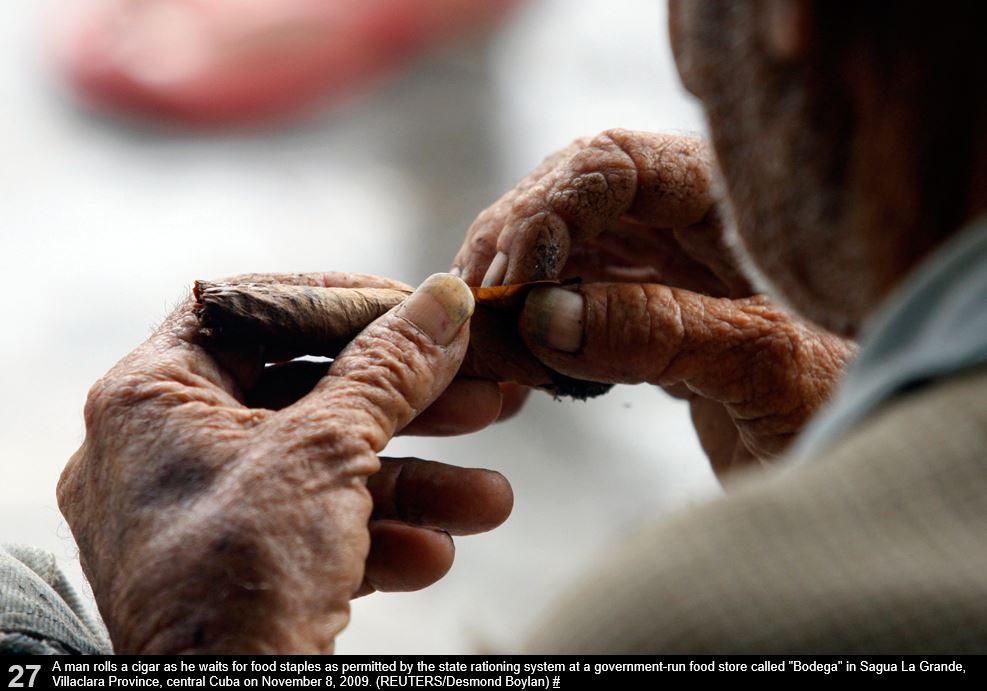
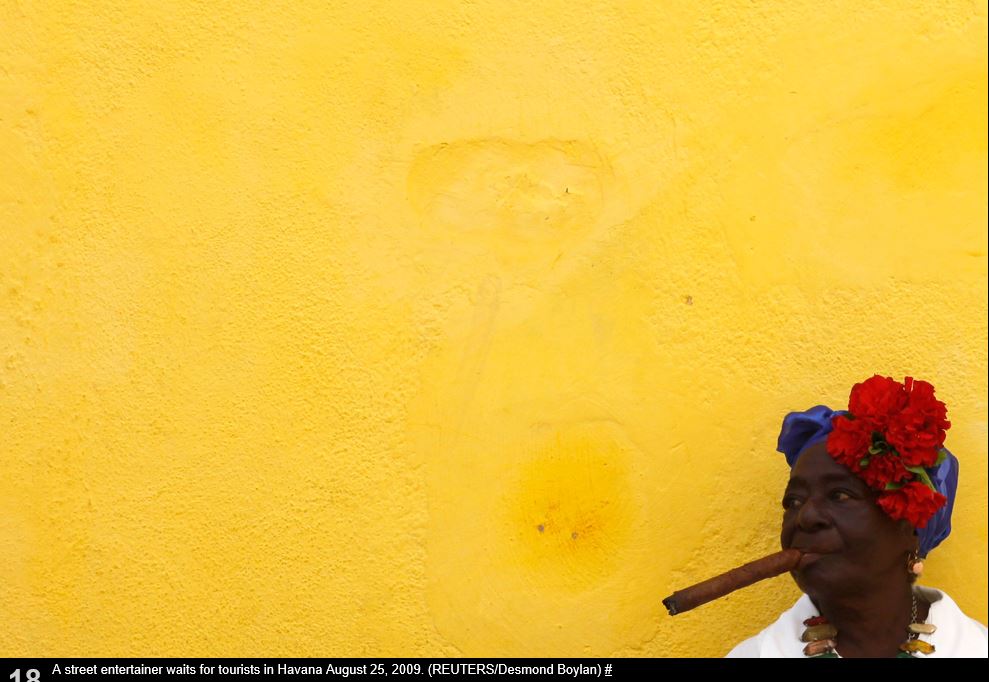
That night we went to a performance in the theater
b.jpg)
Saturday December 2
Cemetery, Hemingway House, Port, Fort
Museo Hemingway
9-4 Mon-Sat, 9-12:30 Sun
Ernest Miller Hemingway
(1899 - 1961) was an American writer and journalist.
He produced most of his work between the mid-1920s and the mid-1950s, and
his career peaked in 1954 when he won the Nobel Prize in Literature.
His pain and suffering pain from the African
accidents, kept him from traveling to Stockholm to accept the prize, so he sent
a speech defining his life instead:
Writing, at its best, is a lonely life.
Organizations for writers palliate the writer's loneliness but I doubt if they
improve his writing. He grows in public stature as he sheds his loneliness and
often his work deteriorates. For he does his work alone and if he is a good
enough writer, he must face eternity, or the lack of it, each day.
His books include
The Sun Also Rises (1927)
A Farewell to Arms (1929)
For Whom the Bell Tolls
(1940)
The Old Man and the
Sea (1951) won Pulitzer Prize
True at First Light
(1999)
Hemingway had permanent
residences in Key West, Florida, and Cuba during the 1930s and '40s.
In 1959
he moved from Cuba to Idaho, where he committed suicide in
1961.
These are MY PICTURES:
c.jpg) |
MY PICTURES
<--- Hemingway house in Key West, Florida
Hemingway house in Havana, Cuba
b.jpg) |
Harold and Arturo inside the house in Havana
.jpg)
x |
Arturo knew the guides, so they let us go inside the house!
x.jpg) |
In 1939, Hemingway crossed to Cuba in this boat
.jpg) x x |
6-toed cat graves
b.jpg) |
Hotel Ambos Mundos where Hemingway lived in room 511 and wrote For Whom the Bell
Tolls
.jpg) x x |
Hotel Ambos Mundos
at
Obispo No 153
x.jpg) |
| x |
x |
Castro and Hemingway (showing off hunting trophies with his swashbuckling
friend?
.jpg)
The Russian Embassy and
Government watch towers
b.jpg)
Then we visited the port: Marina
Hemingway
If you want to go Deep
Sea fishing, you leave from Marina Hemingway.
Marlin office next to Papa's Restaurant.
4 hours cost is $150.
b.jpg)
d.jpg)
b.jpg)
Cemetery
(Necropolis
Cristobal Colon)
A cemetery and open air museum.
The cemetery was built in 1876 and has nearly one million tombs
- One million people buried here.
It is one of the most famous cemeteries in Latin America, known
for its beauty and magnificence.
Some of the gravestones are decorated with the works of sculptors
of the calibre of Ramos Blancos, among others.
Romanesque northern gateway.
.jpg)
Monument to the firefighters (1890)
>>>>
b.jpg) |
xxb.jpg) |
Tomb of independence leader General Maximi Gomez (1905)
Familia Falla Bonet mausoleum (1886).
Tomb of Senora Amelia Goyri.
She died while giving birth on
May 3, 1901.
Marble figure of a woman
holding a large cross with the baby in her arms. When the body was exumed, the
baby was in her arms.
Senora Amelia
is the focus of a miraculous cult, and its followers never turn their backs on her.
.jpg)
Tomb of Orthodox Party leader Eduardo Chibas
During the 40's and 50's Chibas was relentless crusader against the political
corruption of his time.
As a personal protest he committed suicide during a
radio broadcast in the 1951.
At his
burial ceremony, a young Orthodox activist named Fidel Castro
jumped on top of Chibas
grave, and made a fiery speech denouncing the old establishment.
It was the political debut
of the most influential Cuban of the 20th century.
b.jpg)
Military graves
b.jpg)
|
Grave of Arturo's first wife
.jpg) |
The PAUPER graves.
After one year in 4' box, the remains are moved to the smaller boxes
(about 18 inches?)
and tucked away. Another body is placed in
the larger box.
.jpg)
|
x.jpg) |
The Fortaleza de San
Carlos de la Cabana
b.jpg)
The most impressive fortress from colonial times, particularly
its walls.
La Cabana was constructed at the same time as
the other forstress
(Castillo do los Tres Santos Reyes Magnos del Morro) at the end of the 18th century.
b.jpg)
18th century fortress
complex, the biggest in the Americas, located on the elevated eastern side of the
harbor entrance in Havana, Cuba.
Construction
1763 -1774
by King Carlos III of
Spain, the controlling colonial power of Cuba, following the recent capture of Havana
by British forces (an exchange was soon made to give Cuba back to the Spanish in
exchange for Florida).
La Cabana was the largest
colonial military installation in the New World by the time it was completed in
1774, at great expenses to Spain; so much the King proclaimed it should be visible
from Spain having cost so much and take so long to be finished.
The fortress served
as both a military base and prison over the next two hundred years for both Spain
and an independent Cuba.
La Cabana was used as
a military prison during the Batista regime.
b.jpg)
In January 1959, rebels
led by Che Guevara captured La Cabana and used it as a headquarters and as a military
prison for several months while leading the Cuban revolution.
During his five-month
tenure in that post (January 2 through June 12, 1959), Guevara oversaw the revolutionary
tribunals and executions of suspected war criminals, traitors, chivatos (informants),
and former members of Batista's secret police. The complex is now part of a historical
park, along with El Morro, and houses several museums open to the public. From there,
every night a cannon shoot rumbles, so called "El Canazo de las 9",
a custom, kept from colonial times, signaling the closure of the city wall doors.
Cannon
ceremony @ the Cabana Fortress at 8:30 pm
b.jpg)
Sunday December 3, Car Tour, Lennon / Lenin, Tropicana
REVOLUTION SQUARE in Havana
Approaching the square: NO TRAFFIC, NO CARS, NOTHING. No revoluton here.
b.jpg)
In the square. This is my picture.
b.jpg)
Stop the car. I get out of the car. I'm in the square. It's just me.
This is December, 2000.
c.jpg)
I visited in 2010. This is one year earlier in 2009. It was a very different story.
This is the same REVOLUTION SQUARE.
This picture is over half a million Cubans gathered for a "Peace without
Borders" concert on 2009 September 20.
million.jpg)
The face on the side
of the building is Ernesto
Guevara (1928 - 1967)
Commonly known as El
Che or simply "Che".
An Argentine Marxist
revolutionary, physician, author, intellectual, guerrilla leader, diplomat, military
theorist, and major figure of the Cuban Revolution. Since his death, his stylized
visage has become a ubiquitous countercultural symbol and global insignia within
popular culture.
He was a determined Marxist and
a heroic guerrilla willing to confront the most powerful forces of imperializm without
any thought for personal safety or profit.
Che traveled to Cuba aboard
the yacht, Granma, with the intention of overthrowing U.S.-backed Cuban dictator
Fulgencio Batista. He soon rose to prominence among the insurgents, was promoted
to second-in-command, and played a pivotal role in the successful two year guerrilla
campaign that deposed the Batista regime.
Following the Cuban
Revolution, Guevara performed a number of key roles in the new government. These
included reviewing the appeals and firing squads for those convicted as war criminals
during the revolutionary tribunals, instituting agrarian reform as minister of industries,
serving as both national bank president and instructional director for Cuba's armed
forces, and traversing the globe as a diplomat on behalf of Cuban socialism.
Such positions allowed
him to play a central role in training the militia forces who repelled the Bay of
Pigs Invasion and bringing to Cuba the Soviet nuclear-armed ballistic missiles which
precipitated the 1962 Cuban Missile Crisis.
Additionally, he was
a prolific writer and diarist, composing a seminal manual on guerrilla warfare,
along with a best-selling memoir about his youthful motorcycle journey across South
America. Guevara left Cuba in 1965 to incite revolutions, first unsuccessfully in
Congo-Kinshasa and later in Bolivia, where he was captured by CIA-assisted Bolivian
forces and executed.
Guevara remains both
a revered and reviled historical figure, polarized in the collective imagination
in a multitude of biographies, memoirs, essays, documentaries, songs, and films.
Time magazine named him one of the 100 most influential people of the 20th century,
while an Alberto Korda photograph of him entitled Guerrillero Heroico (shown), was
declared "the most famous photograph in the world."
Reuters/Desmond
Boylan photo: Casto, Jose Marti, Che
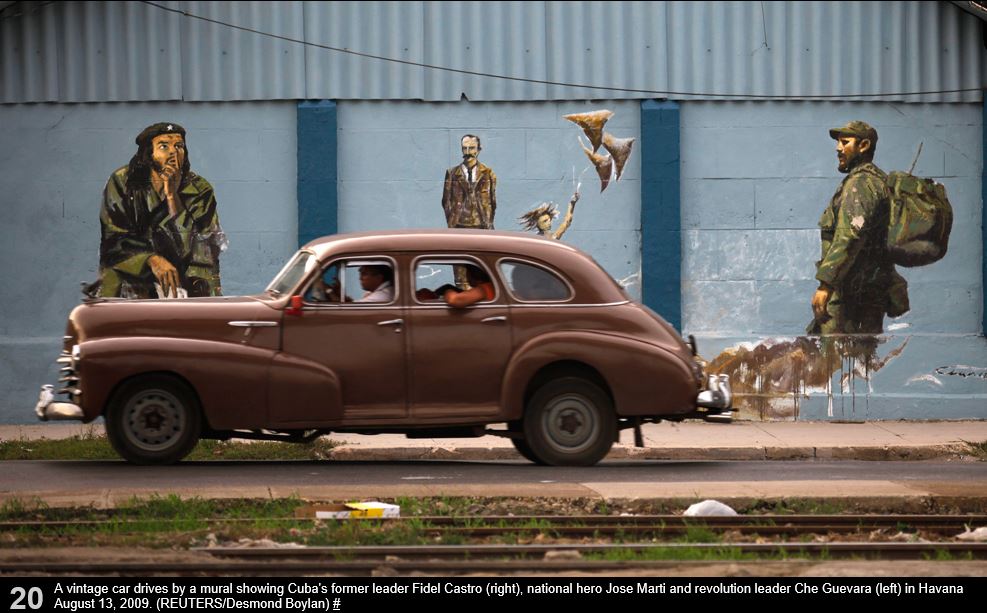
|
The spot where Fidel proclaimed the socialist nature of the
Cuban Revolution on April 16, 1961.
.jpg) |
b.jpg) xx xx |
The Havana city wall
|
A fragment of the former city wall.
.jpg)
|
xx.jpg) |
Lunch at a Paladar.
4 USD for a lot of food!
xb.jpg) |
xb.jpg) x x |
The Lennon / Lenin Story
OK, this is a story. I had done some research on
things that I wanted to see in Havana. I told Arturo I wanted to see the statue
of Lenin.
So he takes us to Parque John Lennon where a bronze statue of John Lennon is
sitting on a bench. Oops, WRONG LENIN!!!!!
I told him I wanted to see
"Vladimir" Lenin, not "John" Lennon! That was a bit of
a drive, we got stopped and rerouted by authorities, but we got to Parque Lenin.
Parque Lennon
(as in "John")
The Story of the John Lennon Statue in Havana, Cuba:
How Fidel Castro Finally Caught Beatlemania
http://www.slate.com/blogs/atlas_obscura/2014/01/10/the_story_of_the_john_lennon_statue_in_havana_cuba.html
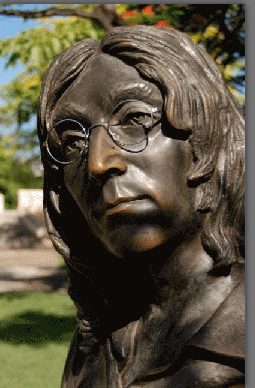 By Ella Morton
Photos: Carlos Montoya and Gerry Zambonini
By Ella Morton
Photos: Carlos Montoya and Gerry Zambonini
February marks 50 years since The Beatles first appeared on The Ed Sullivan
Show, igniting a global phenomenon. But when Beatlemania swept the world, communist
Cuba resisted. Believing the Fab Four were the epitome of mindless, vulgar consumerism,
Fidel Castro declared a nationwide ban of Beatles music in 1964.
Cubans eager to experience the rock-and-roll revolution resorted to trading
smuggled tapes of "I Want To Hold Your Hand."Almost four decades later, with
"All You Need Is Love" playing in the background, Castro unveiled a bronze statue
of John Lennon in a Havana park. At the ceremony, held on the twentieth anniversary
of Lennon's 1980 murder, Castro spoke of his respect for the former Beatle.
"What makes
him great in my eyes is his thinking, his ideas," he said. "I share
his dreams completely. I too am a dreamer who has seen his dreams turn into
reality."
Castro's change of tune resulted from re-imagining
Lennon as political dissident hounded by the U.S. government. In the dictator's
eyes, Lennon was no longer a symbol of the decadent West, but a revolutionary
dedicated to emancipating the working class. That conveniently made him a posthumous
ally of Cuba ‚ hence the need for a life-sized bronze statue and an accompanying
open-air concert of Lennon's music.
The statue, which captures Lennon in his long-haired,
anti-war activism years, sits on a bench in John Lennon Park. Its iconic circular-rimmed
glasses have been stolen so often that a guard now stands nearby holding them,
poised to place them on the statue's face when visitors approach.
On one of the benches of the park, nearer the corner of streets 17th and 6th,
there is a sculpture of the former Beatles member John Lennon, sculpted by Cuban
artist Jos’‚ Villa Sober, seated on the bench's right end. On a marble tile
at the foot of the bench there is an inscription reading: "Dir’‚¡s que soy
un so’‚ador pero no soy el ‚nico" John Lennon, which is a Spanish translation
of the English lyrics, "You may say I'm a dreamer, but I'm not the only
one," from the song "Imagine".
The sculpture of Lennon is currently not wearing his signature round-lens glasses,
which have been stolen, or vandalized, several times. However, during the day,
a security guard can be found sitting next to the bench, and he will place glasses
on the statue if there is a request.
The statue was unveiled on 8 December 2000, the 20th anniversary of Lennon's
murder. One year later, Cuban author Ernesto Juan Castellanos wrote a book about
the statue, John Lennon en La Habana with a little help from my friends, and
about the ban that John Lennon and The Beatles suffered in Cuba during the 1960s
and 1970s.
Parque Lenin
(as in "Vladimir")
c.gif)
Approximately 15 miles (25 km) south of Havana.
Arturo
was not really happy about taking us to this place. It was a bit of a drive. At
one point we had to stop the car at a checkpoint and the police rerouted us to
our destination. We got there and we were the only car in the parking lot.
The park
was inaugurated on April 22, 1972 by Fidel Castro
From
http://www.lahabana.com/guide/parque-lenin/
Parque Lenin, where nature, culture and relaxation meet, is a great place to
go for a picnic. Visiting it will take most of your day as you enjoy the
park's many attractions, which include an amusement park with one of Cuba's
few roller coasters, horseback riding, steam train, zoo, aquarium, pools and
various restaurants.
The Rodeo Nacional, an arena where some of Cuba's best rodeos take place is
laso within the park's grounds. At the entrance to the left, there is a small
model airplane field that holds exhibitions every Sunday.
Bear in mind that it is somewhat run down; the train is not working; the aquarium
has just a few fish and the amphitheatre's seats are overgrown with grass and
the stage is just a large piece of rusty iron. Las Ruinas is the only restaurant
and it is not what it used to be.
The only thing that has been very recently
refurbished (reopened in 2009) is the amusement park, which is worth the visit.
The equestrian centre is still working but the horses belong to private individuals
from around. There is really no set price. You have to bargain with them.
What to do here
- Rent a rowboat and cross the lake
.... See the giant
statue of Vladimir Ilitsj Lenin...... Galeria de Arte
Amelia Pelaez ... The Amphitheater
and the Aquarium with crocodiles and fishes.
The huge bust of Lenin, carved in 1982 by Soviet sculptor
L E Kerbel, is a focal point.
The "rugged beauty of the white marble piece captures
your gaze. " Yes it did
that to me.
I'm not sure what it is about Communist countries. I've been to
every one in the world except for North Korea.
.jpg)
My comments: Seriously Run down, seriously. Those are STONE seats
in the picture below! Can you imagine
the effort that went into constructing an Ampitheater with stone seats. It overlooks
this body of water. That island is a little Aquarium with crocodiles and "fishes".
b.gif)
Harold with our excellent tour guides: Arturo and his wife, Wilma
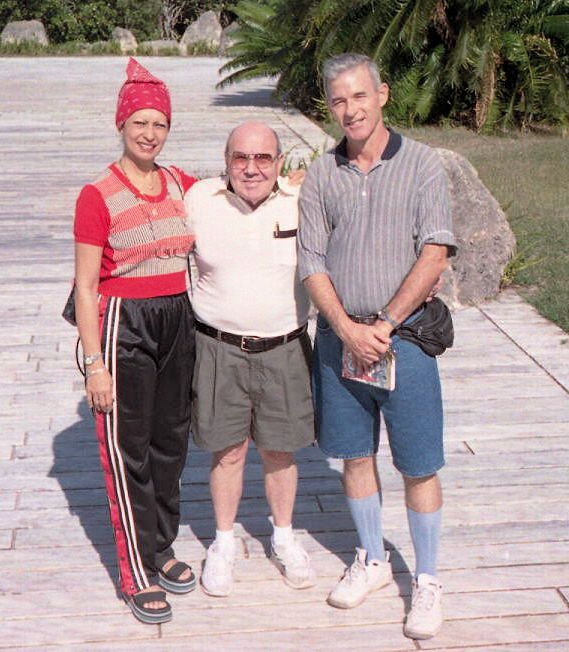
Harold invited them to go to the Tropicana show with us that night....
The Tropicana
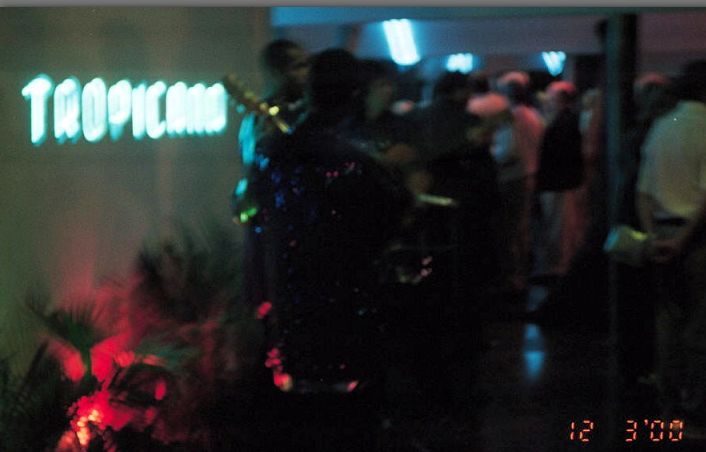
That night Arturo arranged for Harold and I to go to the Tropicana
show at the Hotel Copacabana
(at Miramar 42/44)
That was quite an evening.
I'm writing this seventeen years after the fact, and now I finally understand
and appreciate Harold's generosity.
Harold invited Arturo and Wilma to the Tropicana show. He absolutely insisted that
they join us.
It was quite an ordeal
of an invite.
The cost was $60 USD
per person. Harold pulled the cash out of his money belt proving he would pay for
their tickets.
I was sitting in the
back seat, and uncomfortable with the invitation, and a little embarrassed. Money
being flaunted.
But that is Harold.
Gotta love him.
Arturo and his
wife joined us at the show.
A bottle
of rum for each person is included.
Arturo was sauced, and I was not happy about him driving us back to the hotel.
Again, gotta love Harold.
He
convinced me it would be fine and he convinced Arturo to drive along the Malceon.
I see why Arturo did not want to got that route. A night, the waves splash
over the entire road. The car was soaked. Not good for an already rusting 60's era
VW bug.
I hope they gave it a good
washing when they got home to get the salt spray and water off.
About The Tropicana:
The Tropicana, is a world-known cabaret and club in Havana, Cuba.
It was launched in 1939 at Villa Mina, a six-acre suburban
estate with lush tropical gardens in Havana's Marianao neighborhood.
The spectacular showplace that became The Tropicana evolved
out of a Depression-era bohemian nightclub , operated by Cuban impresario Victor
de Correa.
Its popularity with tourists
grew steadily until the entry of the USA into World War II, which sharply curtailed
tourism to Cuba.
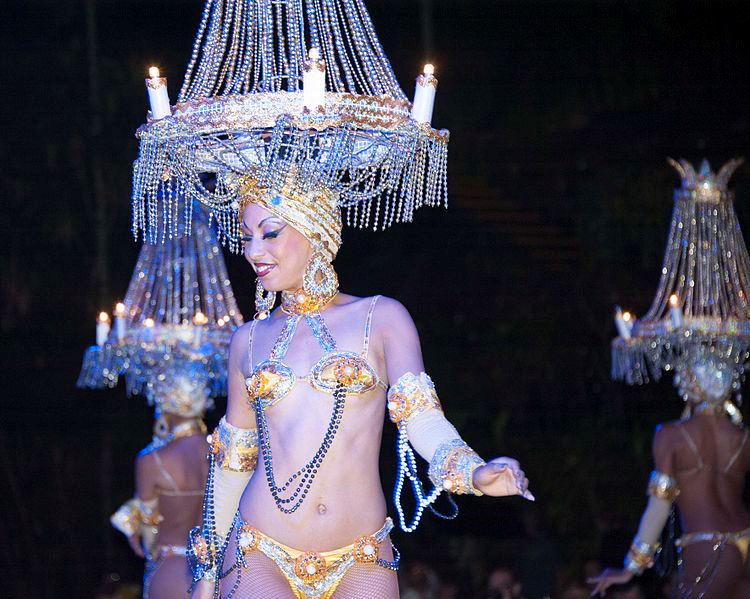 The showgirls are known collectively as "Las Diosas de
Carne" (or "Flesh Goddesses"), Renowned the world over for their
voluptuousness
The showgirls are known collectively as "Las Diosas de
Carne" (or "Flesh Goddesses"), Renowned the world over for their
voluptuousness
The cabaret showcased a kind of sequin-and-feather musical
theater that would be copied in Paris, New York, and Las Vegas.
It was a "Paradise Under the Stars", the Tropicana
became known for its showgirls, conga sounds, domino tournaments and flashy, spectacular
productions.
The Tropicana continues to operate now, attracting tourists
to its Cabaret Shows taking place at 9pm, Tuesday to Sunday, in the open-air Salon
Bajo Las Estrellas (weather permitting).
In 2012, ticket prices were CUC 70, 80 and 90, each including
0.25 liters of rum and various combinations of drinks and snacks. Taxi fare is about
15 CUC from the city center (El Capitolio area).
Monday December 4
Museum
We did not arrange anything with our tour guide Arturo this morning
because I wanted to go see this museum. At the entrance to our
hotel, we asked a transport to take us to the museum. No taxi drivers
would agree to take us. He pointed down the block and indicated that
we had to walk. Harold had to stop a couple times to rest, but
realized how close the museum was located. That is why the taxi wouldn't
take us.
The museum was very interesting and definitely worth taking a couple
hours to see. So here is another good story: When I was
buying my ticket to see the musumm I asked if there was an elevator to get
to the second floor. The girl pretended like she didn't understand me,
so I deduced that there wasn't an elevator so Harold could not see the
primary exhibits of the musuem. He agreed to wait for me to see the exhibits
and he would stay on the first floor. I found out that
"elevator" was the same word in spanish, but you say it with an accent.
The stupid girl was making me feel stupid becuase I did not pronounce
the word "elevator" with an accent. That's a shame. It was a great
museum. I wish Harold could have taken the elevator to the second floor to
see it.
Museo de la Revolucion (The Museum of the Revolution)
b.jpg)
The building has Neo-Classical elements, and was decorated
by Tiffany & Co. of New York. It is a very beautiful building.
It was the the Presidential Palace of all Cuban presidents
until 1959.
b.jpg)
In the years following the Cuban revolution
It became a museum displaying and documents outline Cuba's history from the
beginning of the neo-colonial period.
The building c
ombines Spanish, French and German architectural elements. The building was the
site of an unsuccessful assassination attempt against Batista
in March 1957. Contains a complete documentary and pictures of the Cuban Revolution.
Pavillon Granma
- This
one of the holiest shrines of Cuban communismÂÂÂÂÂ.
It is an 18m motor vessel
Granma that carried Fidel Castro and 81 others from Mexico to Cuba in 1956.
It is behind the musuem.
b.jpg)
SAU-100 tank used by Fidel Castro during the 1961 Battle of
the Bay of Pigs.
b.jpg)
Pasei de Marti (1770) is a
long promenade from the city to the water.
Children playing on the Pasei de Marti.jpg)
Lions, added in 1928, to mark the entrance to the Pasei de
Marti promoenade.
.jpg)
b.jpg)
Getting around
b.jpg)
b.jpg)
.jpg)
A Cuban-made "Camel" bus
.jpg)
Various pix around town
.jpg)
.jpg)
We drove by the beach
/ resort area at Playas Del Este.
Here are our wonderful host
and guide Wilma and Arturo.
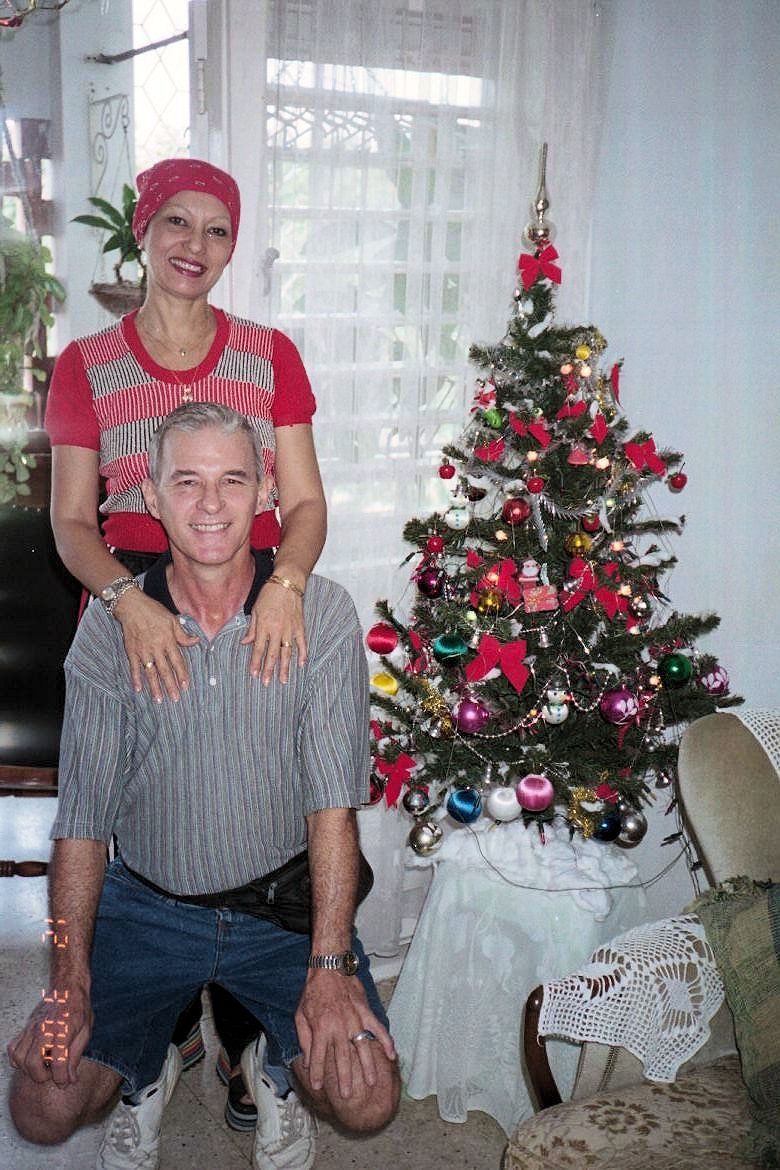
xxxxxxxxxxxxxxxxxxxxxxxxxxxxxxxxxxxxxxxxxxxxx
Tuesday December 5 Travel home
Today we had a 7:00 AM flight on Aerocaribe from
Havana to Cancun.
When we got to Cancun, we went directly to the
Hilton. What luxurious sight to behold.
A great place to unwind after a hectic time in
Cuba.
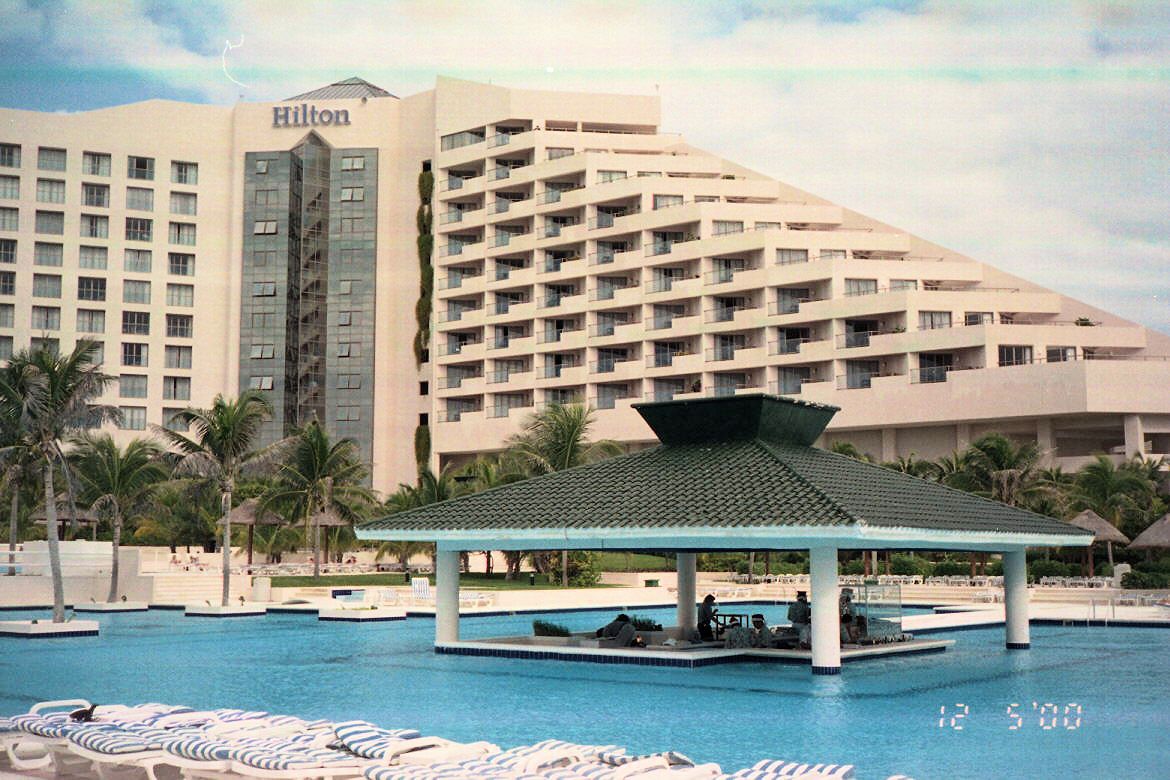
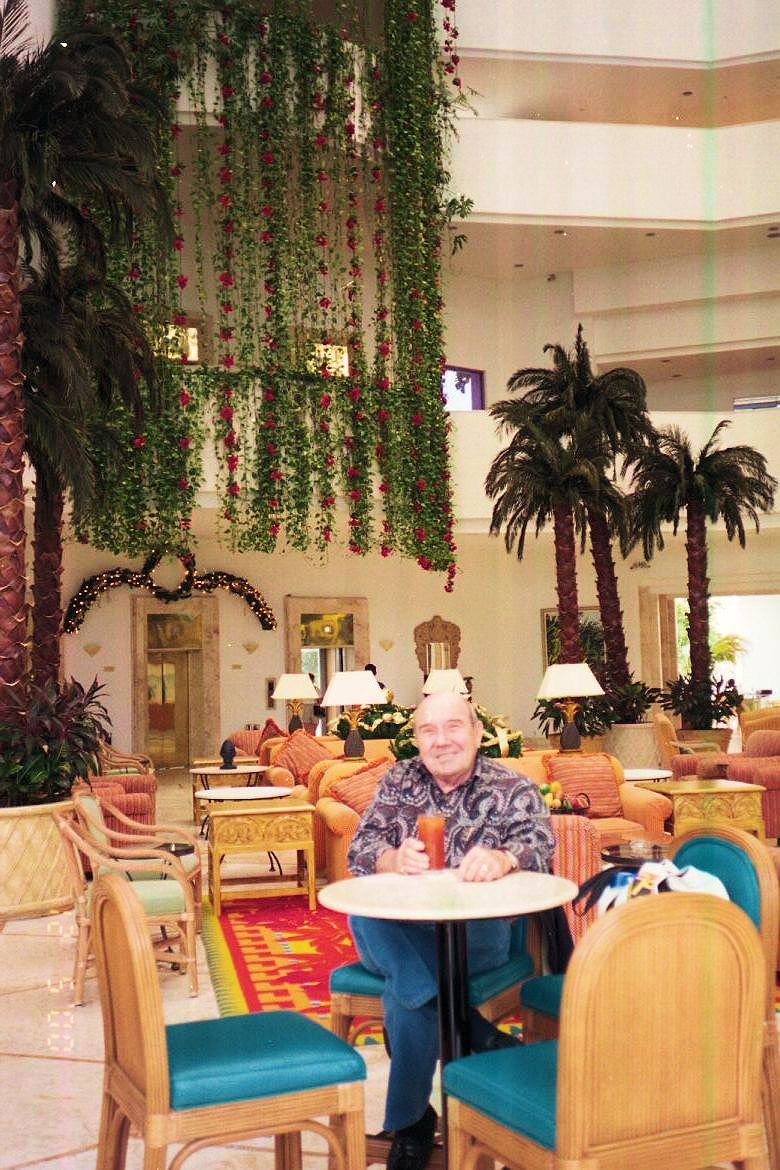
I flew from Cancun to
Houston to Atlanta (arriving at 12:37a on Wed Dec 6.
Harold flew from Cancun
to Houston to Tulsa arriving at 10:09p.
Whew. Home.
Interesting:
About Banks, per Arturo:
The more money you have in the bank, the lower interest
rate you may get.
The bank will acknowledge that you have the money, but
they may inform you that you cannot have access to it until x years later.
About Stalin per Arturo: "The sun shines and you can block part
of it with your hand."
Arturo really likes Che Gevera. He would not give an opinion
about Castro.
Wilma and he are going to divide their apt to rent a place
for foreigners as $30 to $40 a night.
Hmmm. I think I will pass. I smelled
gas.
They pay about $2 per month for rent.
At the new place you pay $2
a month for 0 years and then you own it.
Milk is $1.65 a gallon. Big lunch was $4.50, beer $1. Mojito
drink $25.0.
In general, the people are [adjective] happy
beligerent
unknowingly they don't know
any better. They are in the dark.
Arturo "I can leave any time"  He played basketball in Czech
and Germany. He taught in Angola? For
22 months.
Arturito has a masters in Economics.
Restaurant tries to get us to order what they want you to order.
Because of lack of groceries. No bread for his sandwich, so he didn't order a sandwich.
Money in the bank. The more money that you have in the bank,
the lower the interest rate that you earn.
If you have 10,000 pesos, the government one day may say have
have 5,000. The Government can freeze access to money at any time.
Communism - everyone is equal.
An architect in Cuba makes $17 US a
month. Design engineer $22 a
month
The average Cuban earns no more than $10 to $15 a month.
Low wages have turned the country into a nation of beggars.
Cuban monthly pensions are less than the $3.20 a carton of
American eggs cost here.
More than $1 billion flows each year from Cuban-American communities
into the hand of relative and friend on the island who cannot eke out a living on
their salaries alone.
Following the ruin of the sugar can industry, Castro vigorously
promoted tourism, Cuba's top industry these days.
But ordinary Cubans cannot enjoy the plush hotelds, resort
and service reserved solely for foreigners.
I feels like We Cubans are treated like third-class citizens
in our own landÂÂÂÂÂ.
Waves pound El Malecon, a seawall and roadway in Havana, Cuba
on March 22nd, 2009. Original here. (Neiljs / CC BY-SA) #
More pix at:
http://www.boston.com/bigpicture/2009/11/scenes_from_havana.html
Harold was such a fun, interesting person to travel with.
He's generally very positive, given all his circumstances. He's been through
alot in life: Oklahoma dust bowls, Selling moonshine during the depression, he was
on the Sheffield Steel National negotiating committee. I think he drank a
couple bottle of Scotch when we were there. That does not bother me
- a co-worker who has been to Cuba four times now has figured out that Cuba waters-down
their liquor. So a full bottle of Scotch from Cuba is like half a bottle of American
Scotch. Harold was a trooper. Even when he was uncomfortable (in pain), he
forged ahead... What a great trip.
The Atlanta Journal Constitution May 4, 2005
Cubans have mixed feelings on pamphlets dropped by U.S.
The United States has been quietly
waging a new war on information on Cuba, trying to promote democracy by dropping
hundreds of thousands of leaflets in the front yards of Cuban residents across the
island. The Mystery pamphlets arrive in the middle of the night on people's lawns
and have become the subject of both curiosity and derision among Cubans. One recent
leaflet included the text of President Bush's State of the Union speech; another
features the U. N. Universal Declaration of Human Rights. Some people think that
irritating Cuban President Fidel Castro is reason enough to distribute the pamphlets;
others fear that the state security apparatus is closely watching to see who's interest
in them. And some resent the interference. "I'm against these pamphlets,"
seaman Juan Dominguez told the Chicago Tribune. "There is no reason for the
United Statues to be involved in our affairs. We are a free country. We don't go
to the Unites States and hand out information." Nevertheless, the campaign
has been a heartening sign for some. "There are a lot of things that are not
going well, " said Emilie Roja, who said he's a former political prisoner.
The Atlanta Journal Constitution Jan 3, 2016 article by Nick Miroff
The largest public housing project in Cuba is Alamar, with 100,000 residents. It is Cuba's most equal place, because everyone pretty much has an identical apartment.
They achieved their goal and provided housing, and created a place of equality for the socialist society. It was a model city... 40 years ago, but..
The country's ideological foundations are cracking, and a new uncertainties are coming... there are rising inequalities .... [leading to] the breakdown of Cub's socialist welfare state.
Three quarters of the labor force works for the state. Average government salary is $20 a month.
After 25 years of economic austerity, a collective exhaustion has set in, the toll of steady emigration, corruption, and knowing from globalization influences, that Cubans live better in almost any other country than their own.
Fidel is 89, and current President Raul Castro is 84
xxxxxxxxxxxxxxxxxxxx
Palacio de los Capitanes Generales (1776)
Palacio del Segeundo Cabo (1772).
It was the Supreme Court, now it is the Cubano del Libro
Museo de la Ciudad
Sports City
Catedral de San Cristobal-
Baroque facade with 2 unequal towers
Palacio di los Capitanes
on the west side of Plaza de Armas. One of Cuba's most majestic buildings. Model railway.
Arturo invited us to dinner Monday night, but
I wanted to be in bed by 8.They ended up working late anyway.
Note for Harold with code from Arturo.
Xxxxxxxxxxxxxxxxxxxxxxxxxx
pix at:
http://www.boston.com/bigpicture/2009/11/scenes_from_havana.html
Collected here are recent photos from in and around Havana,
Cuba. (35 photos total)
In 2009:
Havana,
the capital city of the island nation of Cuba
Population 4 million people - 20% of the entire population
of Cuba.
founded by the Spanish in 1519
Havana is the seat of the state-run (faltering) economy
President Raul Castro has even gone so far as to warn Cubans
that their socialist system must change - and to invite (limited) criticism of the
state (Boston.com News Stories in photographs)
Cuba's economic woes are compounded by the 50-year-old trade
embargo imposed by the United States, a practice recently condemned (again) by the
United Nations with a vote of 187-3.
Xxxxxxxxxxxxxxxxxxxxxxxxxxxxxxxxx
This page and all other pages in the
http://www.mytrips.com web site, along with the journals, images, and photos are Copyright ©
2025 by Suzanna Travels. All publication rights are reserved. Email: web@
mytrips.com Remove the space after the @
c.jpg)
.jpg) This
is Harold in the shuttle to the other hotel, the Habana Riviera
This
is Harold in the shuttle to the other hotel, the Habana Riviera
d.gif)
.jpg)
b.gif)
.jpg)
.jpg)
.jpg)
Parque%20Central2.jpg)
b.jpg)
b.gif)
AngeloZanelli2.jpg)
.jpg)
.jpg)
.jpg)
.jpg)
b.jpg)
Robotbreeder.jpg)
.jpg)
c.jpg)
.jpg)
b.jpg)
.jpg)
.jpg)
.jpg)
b.jpg)
.jpg)
.jpg)
.jpg)
PlazaVieja.jpg)
PlazaViejaBrianSnelson.jpg)
b.jpg)
b.jpg)
b.jpg)
c.jpg)
b.jpg)
.jpg)
.jpg)
.jpg) x
xb.jpg)
.jpg) x
x.jpg)
.jpg)
b.jpg)
b.jpg)
d.jpg)
b.jpg)
.jpg)
b.jpg)
b.jpg)
.jpg)
b.jpg)
b.jpg)
.jpg)
.jpg)
.jpg)
b.jpg)
b.jpg)
b.jpg)
b.jpg)
b.jpg)
b.jpg)
c.jpg)
million.jpg)
.jpg)
b.jpg) xx
xx.jpg)
.jpg)
b.jpg)
b.jpg) x
x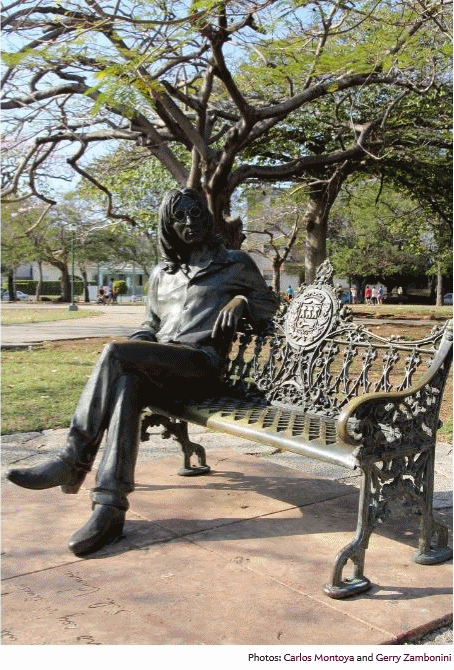
 By Ella Morton
By Ella Morton c.gif)
.jpg)
b.gif)


b.jpg)
b.jpg)
b.jpg)
b.jpg)
.jpg)
.jpg)
b.jpg)
b.jpg)
b.jpg)
.jpg)
.jpg)
.jpg)
.jpg)


